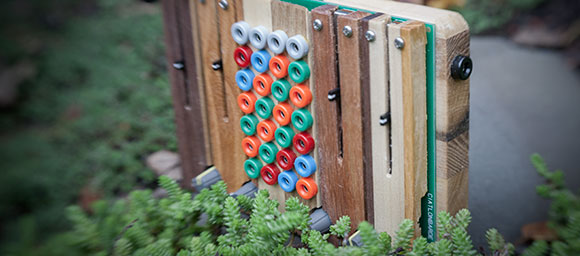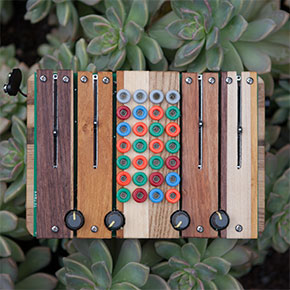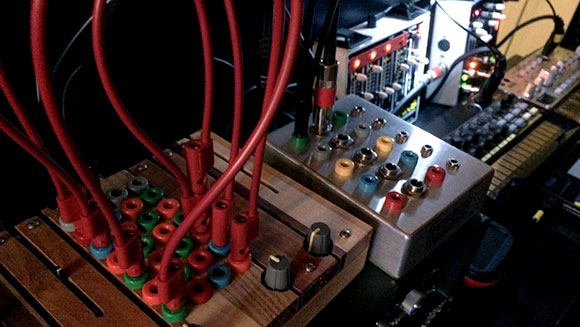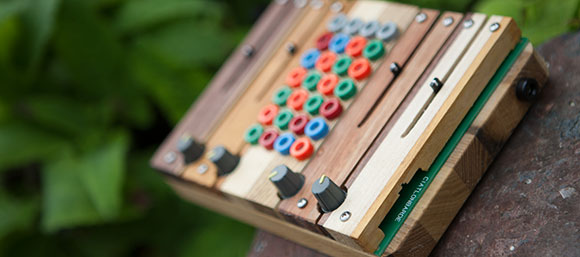The Wooden Synth
Posted: December 20th, 2014 | Author: Nathan | Filed under: gear, music
The Ciat Lonbarde Tetrax Organ, designed by Peter Blasser.
Many readers know that my day job is as a creative director for interactive installations. I create interfaces for a living, so I’m keenly sensitive to the interfaces of musical devices and software. Some I suffer through because the sound is so amazing, and others I deeply admire in for their immediacy or efficacy.
When I first heard about Peter Blasser and his Ciat Lonbarde brand of wooden electronic instruments, I was instantly captivated. The entry-level Tetrax Organ caught my eye: A stereo, four-voice, touch-sensitive synth made of wood, sliders, knobs, and semi-modular patch points? I had to check this out.

Four barres, four sliders, four knobs, 4 columns of patch points. Its sound is far less symmetrical or simple as its appearance would have you believe.
Peter has been the subject of a short documentary, has multiple brands of instruments that he builds, writes poetry about circuit board layouts, which look like nothing you’ve ever seen before. His instruments are in no way traditional in design or timbre. Two compilations have been made featuring the kinds of sounds these instruments can make.
However, a Ciat Lonbarde instrument’s strangeness and underground/indie hype quickly fades from memory once you use one, for a simple reason: Expressiveness. And a design philosophy that takes a stand, Â and winds up massively differentiated from anything that has come before.
[soundcloud url=”https://api.soundcloud.com/tracks/181365218″ params=”color=ff5500&auto_play=false&hide_related=false&show_comments=true&show_user=true&show_reposts=false” width=”100%” height=”166″ iframe=”true” /]
The Tetrax Organ, then, is the most affordable Ciat Lonbarde instrument. It’s simple to play, and quite small: Think of it as the Korg Volca Keys of the Ciat Lonbarde milieu. Its electronic guts live visibly in a sandwich of two layers of multi-colored laminated wood. It has four wooden barres [sic], each with a piezoelectric element that makes the barre sensitive to pressure, each controlling an analog triangle core oscillator. Each barre has a coarse pitch slider, and each pair of barres has an additional tuning knob. “Chaos” knobs for how much the oscillators modulate each other, leading up to colored noise. A host of color-coded 4mm banana patch points in the middle provide modulation options aplenty, which respond to standard control voltage (CV) signals; each column of jacks controls one of the barres. You design tones per barre, as well as interactions between the barres as you start to play with its patchbay. It’s lighter than most stompboxes.

A “format jumbler” like the Low-Gain Electronics UTL-4 makes using control voltage with Ciat Lonbarde instruments a snap. Here the Tetrax is being modulated by an EHX 8-Step Program sequencer, using an EHX Clockworks as the master clock, which is also driving a Korg Volca Beats and Volca Bass. This is a really fun setup for improvising!
The Tetrax Organ doesn’t have filter controls, editable envelopes, MIDI, detents on sliders or knobs for neutral or default tuning, or memory for patch storage. There are no LFO’s (that’s what the oscillators and its semi-modular patchbay is for). It doesn’t have a single status LED, either. This means that you need to turn it on and manipulate it. The only controls are the ones you can actually play. It’s direct, encourages exploration, and allows for very happy accidents. These are manifestations of Peter’s philosophies, rendered in PCBs, sassafras, walnut, steel, and plastic.
[soundcloud url=”https://api.soundcloud.com/tracks/181395836″ params=”color=ff5500&auto_play=false&hide_related=false&show_comments=true&show_user=true&show_reposts=false” width=”100%” height=”166″ iframe=”true” /]
This means it has a sound all its own, but within its own world. I can produce sounds from chaotic to melodic to percussive, and its purity (and sometimes harshness) of tone holds up very well to heavy effects processing. It can be abrasive or sweet, noisy or mellow, deep or piercing, while having its own supremely unique character. Sonically it has a lot more in common with the so-called “West Coast” synth design philosophy, like the Buchla, embracing unpredictability, unearthly sounds, complex timbres, and nontraditional playing styles. If you don’t like the sound, though, it’s not for you. You can go on quite a sonic journey, but you’ll have a hard time leaving its particular sonic terrain (ahem, so to speak).
But let’s get back to the interface of the Tetrax Organ. Touch triggers the amplitude envelope’s opening; releasing the barre also triggers the envelope, usually in the opposite channel. Pressure on the barres modulates volume and has some ability to sustain notes, like it’s retriggering the envelope, or part of it. This leads to a method of play/performance that’s unlike any other instrument, except perhaps a MIDI ribbon controller. You can perform percussively, with vibrato, by stroking, and more. Expressive but with its own rules set, it’s up to you to develop a playing style that gets what you want out of the Tetrax Organ.

A good interface, even if initially mysterious, is defined by a short learning curve. The Tetrax delivers on this in spades.
There are no labels and no proper manual for the device. Usually that would drive me crazy, but part of the Ciat Lonbarde philosophy and aesthetic is about embracing chaos and chance, and the instructions online are absolutely enough to get started. Even the lack of patch labeling is easy enough to commit to memory: Warm colors are outputs, cool are inputs, and certain colors map to certain parameters (red is oscillator output, green is chaos input, etc.). While not guessable, it’s knowable and (somewhat) repeatable, with a very manageable learning curve. Other Ciat Lonbarde instruments, like the Plumbutter (ostensibly a drum machine, but it’s not) and the Cocoquantus (ostensibly a dual digital delay, but it’s not), have reputations for being more cryptic and mystical (crypstical?), probably due to the sheer number of routing options they have, the outre concepts they embody, and their inability to be classified in any sort of traditional electronic music device category.
[soundcloud url=”https://api.soundcloud.com/tracks/181694292″ params=”color=ff5500&auto_play=false&hide_related=false&show_comments=true&show_user=true&show_reposts=false” width=”100%” height=”166″ iframe=”true” /]
The Tetrax Organ’s quirkiness, post-modern design, personality, physicality, timbre, and narrow set of features are specifically what makes it unique and enjoyable. As traditional hardware synths are to virtual software instruments in a DAW, so is the Tetrax Organ to an iPad music app: Simpler than it looks, narrowly focused in what it can produce, but its tactility is its deepest joy.
It’s the simplest and least flexible of the Ciat Lonbarde family of instruments, but that’s a good thing. You can unbox it, plug it in (12VDC power cord or 9V battery), and instantly start making sound with it. It’s the perfect way to get into Ciat Lonbarde’s odd world of off-kilter, organic, and unstable sounds, while still being able to play up to four notes of melody (or drumlike sounds) at once. Peter’s a pleasant guy, but very busy; if you want to learn more from other Ciat Lonbarde owners, there is an active subforum dedicated to Ciat Lonbarde instruments on the MuffWiggler modular synth forum.
Nothing else sounds quite like it. Absolutely nothing compares to playing it.
[soundcloud url=”https://api.soundcloud.com/tracks/182470504″ params=”color=ff5500&auto_play=false&hide_related=true&show_comments=true&show_user=true&show_reposts=false” width=”100%” height=”166″ iframe=”true” /]
Tags: ciat lonbarde, interface, music, music 2014 | No Comments »
Leave a Reply